Ruaha National Park covers an area of 22000 km2 in Southern Tanzania. It was extended in 2008 to include the Usangu Wetland which is a very important source of water for the Great Ruaha river.
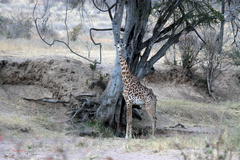
The Maasai giraffe is the only species found
in Tanzania. They are regularly hunted by the
large prides of lions resident in Ruaha
The catchment area also includes the Kipengere Mountains and the Ihefu wetlands and swamps to the South.
It is part of a much larger ecosystem which includes Kizigo, Muhesi and Rungwa game reserves to the West (44000 km2)
Elevation is from 750m in the Ruaha valley to 1900m at Ikungu mountain in the West.
In terms of vegetation the area lies at the boundary of the Maasai steppe savannah and the Eastern miombo woodland and so is a transitional area for game from Eastern and Southern Africa.
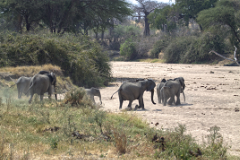
Many of Ruaha's rivers cease to flow in the dry
season, and are known as sand rivers. There
is still water available a few feet down and the
elephants exploit this by digging wells
Commiphoras and combretums are the dominant vegetation as well as acacias and areas of open savannah. Beyond the Ruaha escarpment to the Northwest is miombo woodland.
The Great Ruaha river runs along the Southern border of the Park and is the lifeblood of the area in the dry season, from June to November. The Mzombe River runs much further North beyond the escarpment and is very rarely visited by anyone.
Many of the rivers such as the Mwagusi are higly seasonal, only having surface water during the rains, but holding water underground in their sandy beds for the rest of the year.
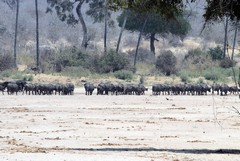
Buffalo crossing the sand river. Herds of over
1000 animals can sometimes be seen
The Ruaha River first dried up in 1993, after the expansion of rice growing in the catchment area to the SW. As more rice was grown, more water was extracted in the dry season (when planting starts 1st October) causing the river to be dry in sections for generally longer periods each year.
Despite some efforts to regulate this it has got steadily worse until in the drought season of 2010/11 it dried up from October to Mid March.
Rice farming continues to expand and the water off take increases. Much of it is wasted due to mismanagement and the methods used to flood the paddy fields.
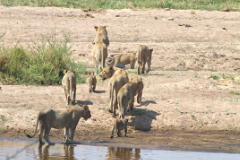
Ruaha boasts a population of around 2000
lions, which is roughly 10% of the World's
population of African lions
2012/13 experienced the lowest wet season river levels ever recorded. The flood waters were poor despite reasonable rain and by June the river was reduced to a mere trickle compared its normal flow rate.
Game viewing is superb in spite of this and maximum densities are seen in the dry season when wildlife congregates near the rivers. Visitor numbers are very low so you will get the true experience of being in the Wilds. There are thousands of elephants and some big lion Prides as well as high numbers of impalas, giraffes and buffalos. At this time of year the elephants dig wells in the 'sand rivers' to get to the water that is still available a short way down.
There are an overwhelming number of different birds, large and small. Some, like the Ruaha red-billed hornbill, are endemic to the area.
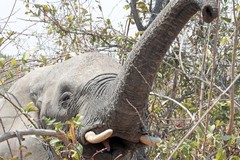
Elephant feeding very close to us
Despite the heavy poaching of elephants from 2009 which peaked in 2014 there are still around 11000 elephants in the larger ecosystem. In recent years Tanzania has cracked down heavily on poaching and in 2019 the situation is reported to be vastly improved. However there is no room for complacency. A survey of the whole ecosystem in 2022 reported 20,000 elephants.
The largest lion prides I've ever seen have been in Ruaha and the area is reckoned to support at least 2000 lions.
Camps are small and select, and the guides are some of the best in Africa. Ruaha was Ernest Hemingway's favourite part of Africa. It's my favourite Park also, despite its problems.
Photographic opportunities are endless as it is a very scenically diverse park and you can get extremely close to the wildlife on occasion.
Read the Story of The Great Ruaha river at Sue Stolberger's Website
Watch the Ruaha in September video.